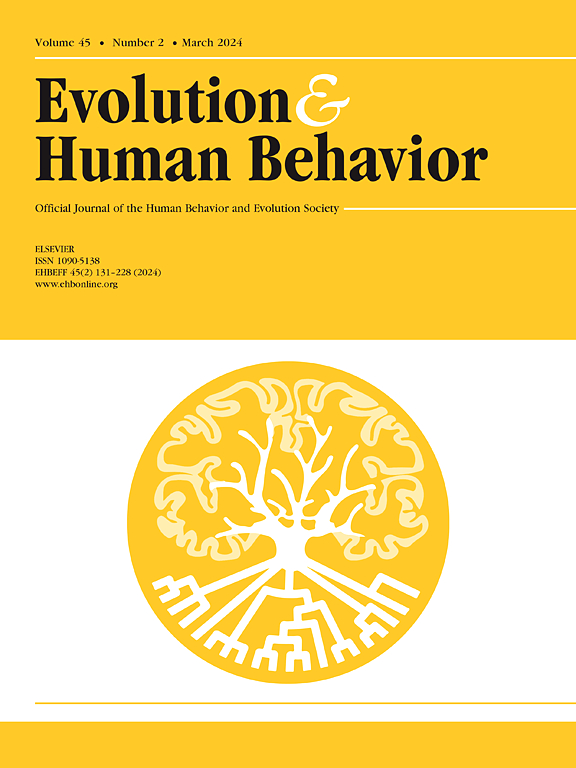Effects of synchronous chanting and identity fusion on perceived ingroup formidability, outgroup threat, and parochial altruism among soccer fans
IF 3.2
1区 心理学
Q1 BEHAVIORAL SCIENCES
引用次数: 0
Abstract
Previous research indicates that social synchrony simultaneously increases ingroup bonding and prosociality, whilst also having the potential to make groups appear more formidable or threatening. However, many such studies have been carried out in artificial settings or in minimal groups which lack preexisting bonds or histories of prosocial action or intergroup rivalry. Here we investigate: 1) whether a synchronous display is perceived as more formidable by ingroups and outgroups, and more threatening by outgroups, in a real-world context involving football (soccer) fans; 2) whether these perceptions extend to behavioral decisions towards ingroups and outgroups; and 3) whether ‘identity fusion’ with the ingroup moderates these relationships. A sample of 771 Brazilian soccer fans took part in a pre-registered conceptual replication online study in which they randomly listened to either a synchronous or asynchronous soccer chant. Both ingroups and outgroups judged the synchronous stimuli to make the performers seem more formidable, but not more threatening. At the behavioral level, we found no effect for synchrony on pro-group behaviors or outgroup derogation, but there was a significant interaction indicating that highly ‘fused’ participants who perceived rival fans to be more threatening tended to engage in more outgroup hostility, even at a cost to self. These results parallel previous studies showing synchrony's effects on perceived ingroup formidability and provide novel insights into the role of social bonding and perceived outgroup threat as contributing factors in the evolution of intergroup conflict in real world situations.
同步呐喊和身份融合对足球迷群体内恐惧、外群体威胁和区域利他主义感知的影响
先前的研究表明,社会同步性同时增加了群体内的联系和亲社会性,同时也有可能使群体显得更强大或更具威胁性。然而,许多这样的研究都是在人工环境中进行的,或者在缺乏预先存在的纽带或亲社会行为或群体间竞争历史的最小群体中进行的。在此,我们研究了:1)在涉及足球迷的现实环境中,同步展示是否被内群体和外群体认为更可怕,外群体认为更具威胁性;2)这些认知是否延伸到针对内群体和外群体的行为决策;3)内部群体的“身份融合”是否调节了这些关系。771名巴西球迷参加了一项预先注册的概念复制在线研究,在这项研究中,他们随机听取同步或非同步的足球颂歌。内组和外组都认为同步刺激使表演者看起来更可怕,但不是更有威胁性。在行为层面上,我们发现同步性对支持群体的行为或外群体的贬损没有影响,但有一个显著的相互作用表明,高度“融合”的参与者认为对手粉丝更具威胁性,他们倾向于参与更多的外群体敌意,甚至以牺牲自我为代价。这些结果与先前的研究相一致,表明同步性对感知到的群体内强大性有影响,并为社会联系和感知到的群体外威胁在现实世界中群体间冲突演变中的作用提供了新的见解。
本文章由计算机程序翻译,如有差异,请以英文原文为准。
求助全文
约1分钟内获得全文
求助全文
来源期刊

Evolution and Human Behavior
生物-行为科学
CiteScore
8.30
自引率
9.80%
发文量
62
审稿时长
82 days
期刊介绍:
Evolution and Human Behavior is an interdisciplinary journal, presenting research reports and theory in which evolutionary perspectives are brought to bear on the study of human behavior. It is primarily a scientific journal, but submissions from scholars in the humanities are also encouraged. Papers reporting on theoretical and empirical work on other species will be welcome if their relevance to the human animal is apparent.
 求助内容:
求助内容: 应助结果提醒方式:
应助结果提醒方式:


